Icy Inverts Cruise 2013 - Shipboard Blog - Dec 13th to Dec 15th
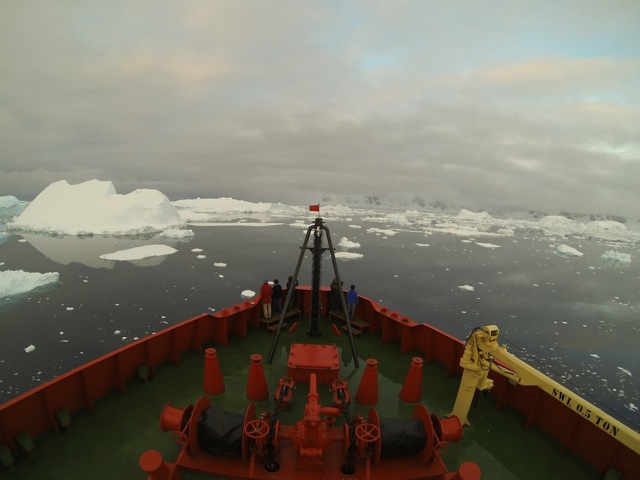
15 Dec 2013 - Palmer Station (64o 46.5` S 64o 03.3` W)
Wow! I cannot believe our collecting time on the R/V Laurence M. Gould has come to an end. A part of me feels as though we were just getting started, while another part of me is extremely exhausted and ready to go home. Since we started collecting on November 27, 2013 we have conducted around 31 Blake, 30 plankton, 30 Yo-Yo Cam, 28 CTD’s, and 16 box core deployments. All together in the 18 science sampling days, that is over 137 different equipment deployments over 28 different stations (one station we sampled three separate occasions) (see above image). That averages out to a little over 7.5 equipment deployments a day. That might not seem like a lot since we were working around the clock (2 shifts each being 12 hour blocks of time), but once you factor in some long transit times and delays due to ice some days it felt like we could not keep up. However, we made it and I think everyone on board would agree that all the hard work has been worth it! There is going to be a lot of interesting research coming from this expedition.
Today we arrived back at Palmer Station (see below image), one of two USA marine stations in Antarctica, to pick up researchers and staff at the station that are traveling back home as well as to pick up some supplies that need to be shipped to various locations. We have been frantically trying to pack up the laboratories on board, as well as all of our samples before arriving to the station to make room for the extra bodies as well as cargo that will be embarking. After a morning of packing, I am really looking forward to have the opportunity to get off the boat! You do not realize how much you miss walking on land until you have been at sea for several weeks. Even if it is just for a couple hours, it will be nice to not be confined to just the ship dimensions, as well as hear something else other than the ships loud noises (especially during equipment deployments). Either later today or in the morning we will depart from Palmer Station and make our journey back to Punta Arenas, Chile. Most of the science crew will have one night in Punta Arenas before making the trek back to the states just in time to make it home for the holidays. I cannot wait to go home and see my family!!!!! I miss my parents and sisters greatly!! The lack of communication with loved ones is always hard on these trips, but I feel extremely fortunate to be a part of this expedition! Two times to Antarctica in one year! I still feel as though it is a dream.
Well, I must be going. There is still work to be done in preparation for the trip home! Thanks to everyone on the ship (science crew, ship crew, and support staff) for an amazing adventure! I really had a blast getting to know all the new people and reuniting with the individuals from the last trip! To my family, I miss you all and I cannot wait to see you in a little over a week!
Contributed by: Dr. Pamela M. Brannock, Postdoctoral Fellow, Auburn University
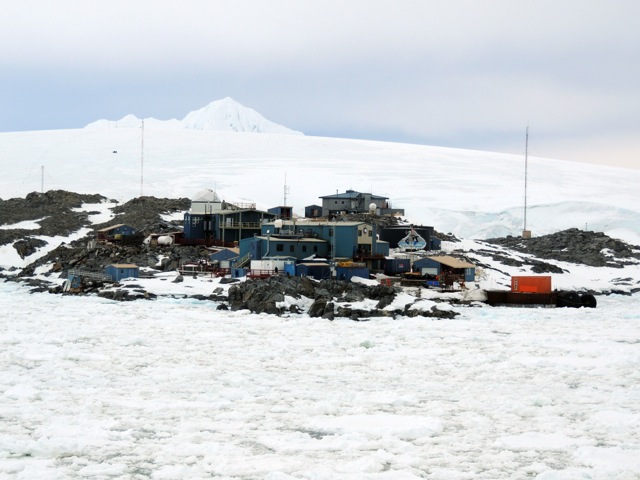
***************************************************************************************
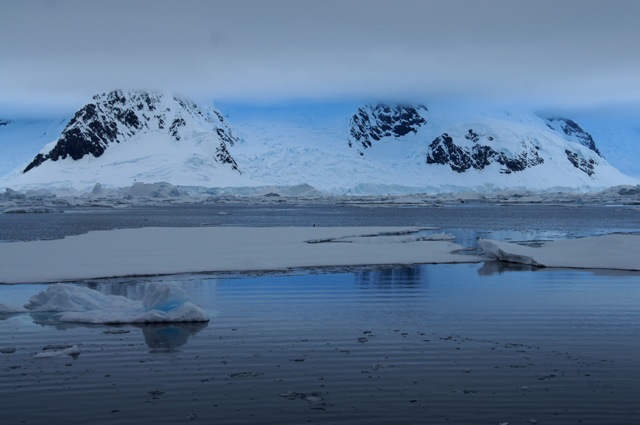
14 Dec 2013 - 65o 20’ S 65o 49’ W
We are nearing the end of the collecting period of the cruise, and on our way back to Palmer Station to pick up cargo and people for the trip back to Punta Arenas, Chile. On the science front, the collections have been wonderfully diverse and fascinating, with examples of several species now on board that, according to my colleagues, are new to science. My primary research goals for the cruise have largely been met, with over 60 videos of pycnogonid walking (slowest duty cycle I’m aware of for any walker of their size, but more detailed analyses of the videos are needed to reveal footfall patterns or gait), a thermal exposure experiment to determine the capacity and kinetics of the cellular stress response of two pycnogonid species, Colossendeis megalonix and Nymphon australe, and literally thousands of pycnogonids preserved in various states for additional study back at CMU.
We’ve been fortunate to be under strong high pressure weather systems for most of the trip, and our only stormy period was earlier this week with a bit of snow and cold winds. We are hoping that trend continues for the 2nd crossing of the Drake Passage. The views from the RV Gould continue to amaze, and I recently saw a shade of blue hanging between mountains that I’ve never seen in nature, and is hopefully captured to some degree in the photo I’m including with this post (see above image). One element that the pictures of scenery do not capture is a sense of scale, so I’m also including another picture that hopefully does this, and it is a fairly nondescript shot of a mountainous shoreline behind pack-ice sea, but the careful observer will find a blue and white cruise ship just to the right of the mountain’s base (see below image).
It’s been an adventure of a lifetime, and my fellow scientists, the crew of the RV Gould (especially the marine science techs), and the project leaders Ken Halanych and Andy Mahon have my deepest thanks for making it so.
Contributed by: Dr. Stephen Roberts, Central Michigan University
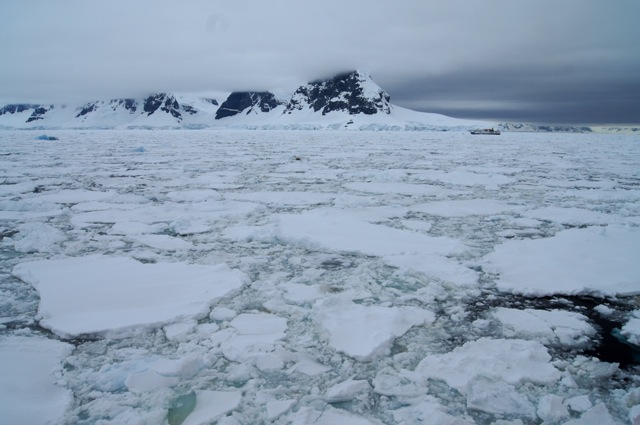
***************************************************************************************
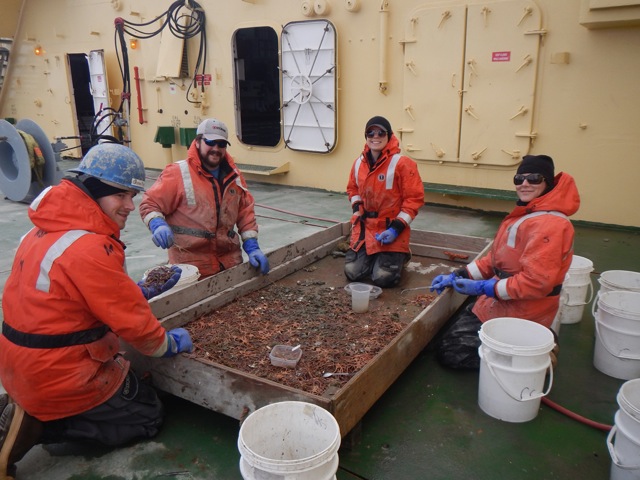
13 Dec 2013 - 65o 20’ S 65o 49’ W
By now you have probably read a lot about the large diversity of animals that we are encountering in our trawls, box cores and plankton tows. We are finding all kinds of critters, ranging from worms, snails and shrimps to sea stars and sea squirts, with many others in between. How do we make sense of all these different forms? How can we classify them in a way that future researchers can understand and reproduce?
The first step is to group the animals into major categories called “phyla” which are defined by certain characteristics. For example, the phylum Echinodermata is characterized by a five-rayed symmetry (think sea star) whereas a segmented worm-like body design is typical for the phylum Annelida. Once everything is assigned to its correct phylum, we can sort them into smaller categories, such as sea stars, brittle stars, sea urchins, sea cucumbers and feathers stars, which are all subcategories within the phylum Echinodermata. That’s exactly what we do when our trawl comes up. We have about 10 buckets on deck which have labels such as “HO” (for Holothuroidea, the Scientific name for sea cucumbers) or “CR” (for Crustacea). We all squat around a big wooden box with all the animals (see above image) or stand around a sieving table, pick out the animals and drop them into their respective buckets.
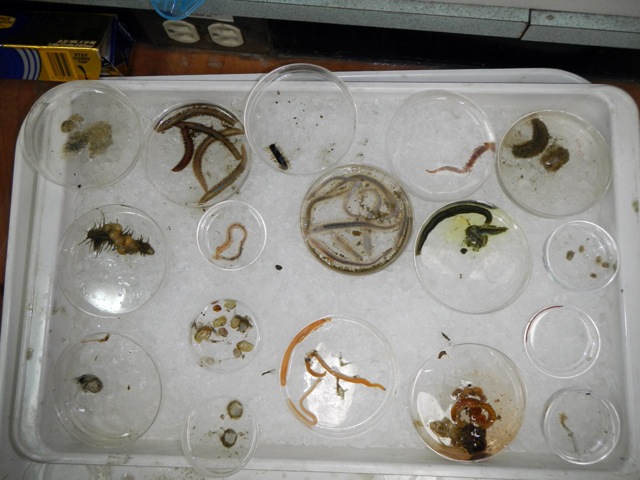
Then we take one bucket at a time into the wet lab and sort its contents on a big tray (see above image). Most buckets contain multiple different species and each species has a scientific name, such as Scotoplanes globosa (a funny looking sea cucumber which we call “sea pig”) (see below image). A species is the smallest unit in our classification system and we usually preserve all the members of a species together. Sounds easy enough, right? Well, it isn’t always. Often the differences between species are subtle and experts, called taxonomists, are needed to properly examine and document them. Sometimes even the experts are stumped, especially when dealing with critters from little known habitats such as the Antarctic deep-sea floor. To complicate matters even more, when we examine the genetic make-up of specimens from different areas, we often find that they are genetically vastly different even though they essentially look the same. We call those “cryptic species” because they are indistinguishable by their looks, but their DNA sequences tell us that they are quite different.
What if we find an organism that does not match any existing species description? In that case, we have to formally describe it. A formal species description is a complex process and must follow firmly established rules that are outlined in the “International Code for Zoological Nomenclature”. Not exactly light reading! One of the rules is that at least one good-looking specimen of the species is deposited in a museum collection so that future researchers can use it as a reference. This specimen is called the “type specimen” and serves as a representative for its species. At this point in our cruise we probably have collected a good number of undescribed species. It will take us a while to find names for all of them. Any suggestions?
Contributed by: Dr. Anja Schulze, Texas A&M Galveston
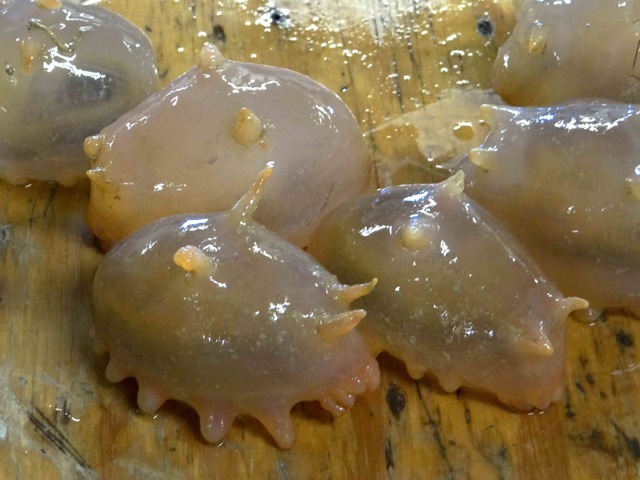
Last updated: 12/15/2013
